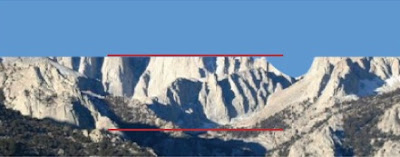The author went on to say that fractions were among the most difficult concepts in elementary math. I'll concede that for the sake of argument. Therefore, division by fractions is the pinnacle; the summit; the Mt Whitney of elementary arithmetic. What does she mean?
(Here's the top of Mount Whitney, just for fun.)
How about an easy one first. 3/2 ÷ 1/2 = ?
3 halves divided by 1 half. How many times does 1 of the halves go into 3 halves? Three. Right?
Another approach I like is to convert 3/2 into a decimal number (1.5) and 1/2 into a decimal number (.5)
now we can see how many times .5 goes into 1.5? Three. Right? Are you with me?
Now let's do a harder problem.
37/11 ÷ 1/2 = ?
Does the idea of multiplying 37/11 ÷ 1/2 scare you? I used prime numbers just to challenge (irritate) myself and you, but it's not really harder to use primes than any other numbers. You just can't simplify.
Let's see - this means if a whole is divided into 11 parts, we have 37 of those parts. We want to divide that sum by 1/2, which is the same as multiplying by 2.
How do I know? That's the reciprocal property of division. Dividing by 1/2 = multiplying by 2. Or to state it more generally, dividing by a fraction is the same as multiplying by its reciprocal.
If we multiply by 2 we now have 74 of those 11th parts. We can simplify this a bit - that's the same as 6 wholes (6 x 11 = 66) plus (74 - 66 = 8) another eight 11ths left over. That's 6 and 8/11.
This is relatively straightforward if the numerator (top number) is a one. Let's try a more complicated version of this problem.
37/11 ÷ 7/2 =
Ok, that's an ugly combination of numbers but it's not difficult.
If we invert (reciprocal) the fraction we're dividing by, we have this multiplication problem:
Thirty-seven 11ths times two 7ths which is equal to seventy-four 77ths, which looks to be just a smidgeon under one whole.
Can we then convert it into a decimal number to see how much less than one whole we really have?
Sure, just divide 74 by 77 and you have .96 which is just a tiny bit less than one whole item.
Let's try doing this by converting to decimals like the first problem. I'm going to use my calculator now but I'll show how it happens:
37 ÷ 11 = 3.3636... and 7 ÷ 2 = 3.5 so now we are dividing 3.36 by 3.5 or multiplying 3.36 by 1/3.5
Both are the same as writing it 3.36/3.50.
It's still a tiny bit less than one whole item. So our answers match.
Now that you remember how to divide by a fraction, have we lopped off the summit of difficulty?



No comments:
Post a Comment
Type your comment here